The big five are commonly used in the tourism industry, not just in Uganda but all over the world by tour operators. The “Big Five” was a term that was first used by big game hunters and later picked up by tour operators as a way of marketing these animals and making them attractive to tourists. They particularly named five of these animals the “Big Five” because of their ferociousness when cornered; these are the lions, leopards, elephants, buffalo, and finally the rhinos. Buffaloes in Murchison Falls, Uganda. Uganda is one of the few countries in Africa where you can find all five; they are found in almost all the national parks in the country.
In Murchison Falls National Park, you will find four of the big five. This is because rhinos became extinct in the country, so they were accustomed to being protected after being brought in from South Africa. They are found at the Ziwa Rhino Sanctuary. And one can see all the big five when one visits Murchison Falls, with the Ziwa Rhino Sanctuary included in their itinerary.
The elephants (Loxodonta Africana)
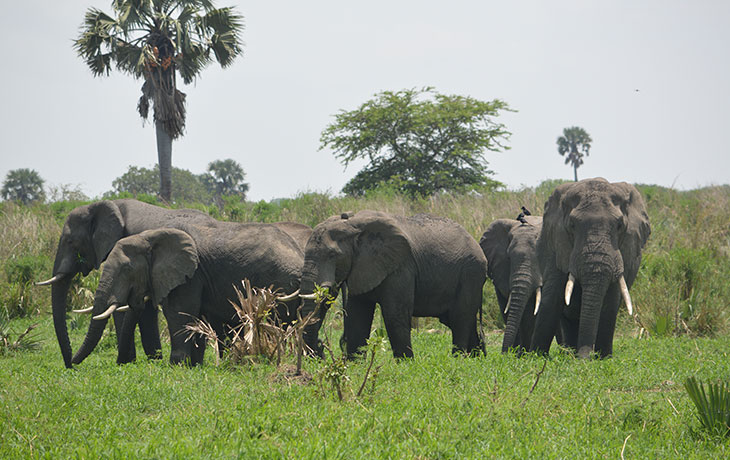
African Elephants (Loxodonta Africana) Also known as African elephants, these are the largest mammals that have ever been known to man in the whole world; they can grow up to 14 feet tall and 30 feet wide. Elephants live in forest woodlands and in savanna areas. They are, however, very social animals, and they live in family groups of up to 100 members. These are one of the most peaceful animals only if left alone and basically not cornered.
Mother elephants are very attentive and protective of their little ones. Elephants are known to be vegetarians. They feed on grass, fruits, leaves, twigs, bark, and seed pods. An adult consumes up to 375 lbs of vegetation and 30–50 gallons of water on a daily basis. Most of the elephants are found in Queen Elizabeth National Park and Murchison Falls National Park, and an estimate of about 500 of them are found in Kibale Forest National Park. The kinds that are found in Kibale Forest are called Forest elephants because of their hairy bodies due to the tropical climate all year round.
The Big Five Lions (Panthera Leo)
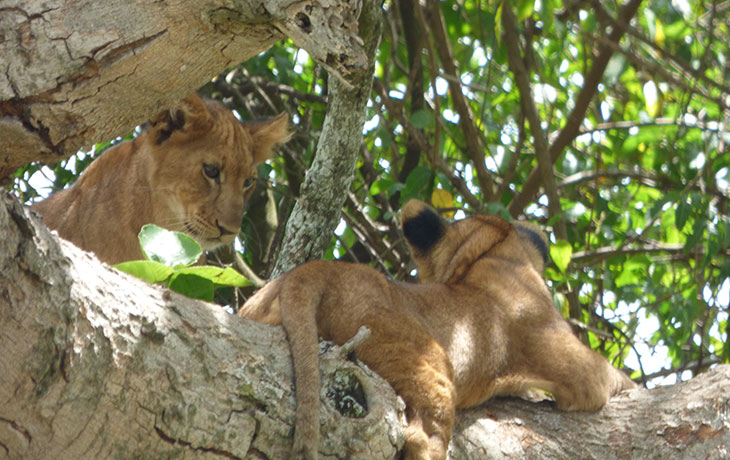
The King of the Savanna, also known as the African Lion, is one of the most sought-after animals by tourists. It is known as the King of Savanna. Lions are high on the food chain; they are the predators, and they are quite excellent hunters. You may be one of the lucky few to get it hunted down. They can live up to 14 years. However, they are said to have had a 30 % decrease in numbers in the last two decades in the whole of Africa.
Lions are extremely good at climbing trees, which is where they rest up to avoid buffaloes if they are not haunting them. They are usually found in groups. Here they are found in Kidepo National Park, Murchison Falls National Park, spotted in Lake Mburo National Park and finally in Queen Elizabeth National Park. The lions found in Queen Elizabeth National Park are commonly called tree-climbing lions, and they are found in the Ishasha sector of the park.
The big five Buffalo’s (Syncerus caffer)
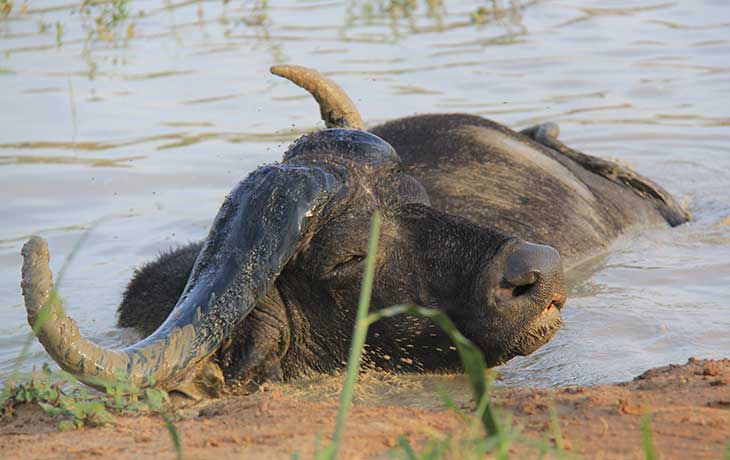
Also known as the water buffalo, there are two types in Uganda; we have both the large savanna buffaloes and the small forest buffaloes. The forest buffalos are smaller. Buffalos are one of the most dangerous animals in Africa, which is why they made the list of the big five. An adult buffalo is as large as 4–6 feet tall and weighs up to 700 kg. Not even a lion would dare attempt to hunt one alone unless it had two more of its kind to help. Buffalos live in open grasslands, and they live in large herds, sometimes numbering close to a thousand.
Since the males fight to take dominance in a herd, the males have lost the fight for another herd. That is why you will find a herd that has a male, females, and calves, while in a different herd you might find only males. Buffalos drink a lot of water, which is why you will often see them along water banks or wallowing in manure during a hot day. Buffalos are very protective of their calves. They will mob a predator targeting the calf when the calf calls for help. The Swahili word for buffalo is Mbogo.
The Rhino
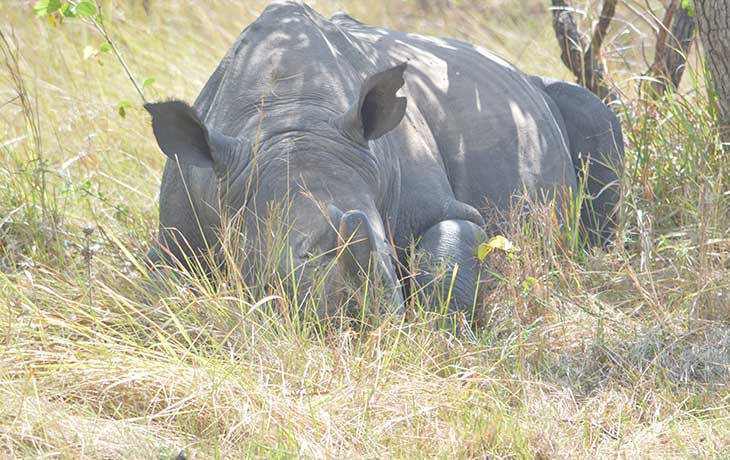
There are two types of rhinos: the black rhino and the southern white rhino. There is not much of a difference between the two except that the shape of their lips is different, i.e., the black rhino has a pointed lip that they use to pick fruit and twigs, while white rhinos have flat lips that they use to graze on grass. We only have the Southern white rhinos that were imported from South Africa and are currently being protected at Ziwa Rhino Sanctuary because rhinos went extinct in Uganda, and it is thus a great fear to send the few Uganda has into the wild before they reproduce and greatly increase in number. The Ziwa Rhino Sanctuary is located along the Kampala-Masindi route to Murchison Falls National Park.
Compared to black rhinos, white rhinos are more social and live in groups. Rhinos are one of the largest mammals in the world, only second to elephants. An adult, fully grown rhino can weigh up to 6,000 lbs. Rhinos are known for being short-sighted and also very short-tempered. However, if you do not tamper with it, it is peaceful. Man is the only natural predator of rhinos, and that is why they became extinct in Uganda. They were hunted down all the time for their horns. For that reason, they are known as endangered species and are protected by the Ziwa Rhino sanctuary.
The leopards (Panthera Pardus)
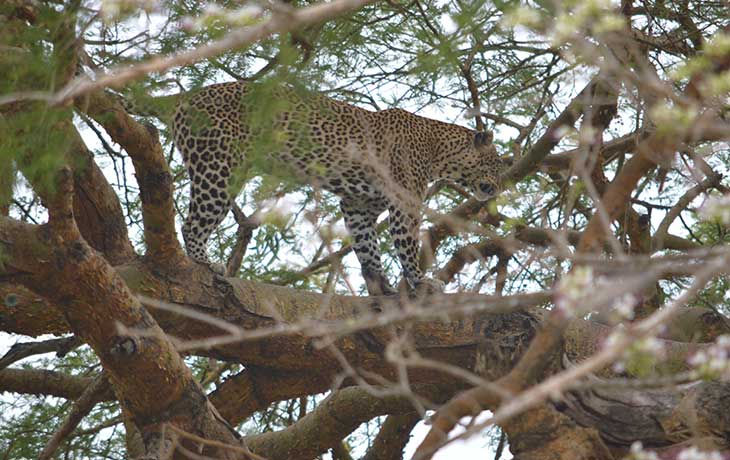
Here in Uganda, these beautiful animals can be seen in Murchison Falls National Park, Kidepo National Park, and Lake Mburo National Park, and rarely will you come across these nocturnal animals in Kibale National Park and Semuliki National Park. Leopards are more numerous and are very difficult to spot because they are nocturnal, which means they are more active at night than during the day.
You may not ever find more than one leopard together because they are very solitary and shy. Unlike other cats, leopards have the ability to live in a wider range of habitats. They climb trees. They can also swim very well compared to lions. An adult male weigh up to 200 lbs. and can jump up to 10 feet straight up. Leopards prefer thick bush and riverine. However, when they have a kill, they prefer to store it up in the trees to prevent lions or hyenas from coming near it.

